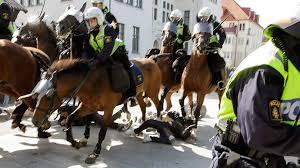2017-09-16
Know Your Enemy: The Riot Tactics of Swedish Police
Know Your Enemy: The Riot Tactics of Swedish Police
Introduction.
The basic function of police in capitalist societies is to maintain private property and to quell social unrest. Throughout different societies and points of history the ways in which this has been done has varied greatly. This text examines how Swedish police use a variety of means during demonstrations, riots and other mass struggles.
History.
Up until the early 2000’s Swedish police were badly trained and had relatively poor tactics. Police followed a strategy where they massed groups of police with shields to hold perimeters of valuable objects and to attack demonstrators. Command was given in a military top-down structure. This approach left police incapable of controlling riots that were on a larger, more mobile and more violent scale than they had previously anticipated: such as in Lund 1991 or the riots during the Swedish EU presidency in Gothenburg 2001.
It was these riots in Gothenburg that made police change their overall strategy. In particular the police were criticized by the Supreme Court (Högsta Domstolen) for breaking the law on multiple occasions; above all they violated the constitutional right to lawful assembly. Another factor to count in is that police lost the physical battle in the streets with the black bloc liberating the central shopping street of Gothenburg for hours as police were unable to deal with masses of committed activists.
https://www.youtube.com/watch?v=vNLmn3Qe1z0
Gothenburg riots of 2001.Take note of the differences between modern policing and the tactics from 2001.
After these events the Swedish police were tasked with finding new strategies and to implement better legal protection for demonstrators. In the mid 2000’s the concept of Särskild Polistaktik (SPT, Special Police Tactic) was invented. Its predecessor was Mobilt Insatskoncept (“Mobile Deployment Concept”) which was then integrated into the wider concept. In the creation of SPT some “leftists” such as Anders Svensson from Socialistiska Partiet (the Swedish branch of the Fourth International) openly collaborated in order to create fewer breaches of the peace during demonstrations.
Overall police strategy: Särskild polistaktik (“Special Police Tactic”)
Police say this about SPT: “The basis for special police tactic consists of four conflict-reducing principles: knowledge, easing situations (“underlättande”), communication and differentiation. The goal is that the individuals in a crowd should feel responsibility for their own and other individuals’ perceived role (“uppträdande”) and action through so-called social control.”
So what does this mean? This means that knowledge about how social movements function and how crowds act, together with a concrete understanding of individuals and groups in a given situation is important for police. During the 2001 EU-summit riots police claimed that Attac were a militant organization, a suggestion that hardly aided them in the streets.
Easing situations means that police attempt to engage demonstrators in order to “help” them with things such as routes and engage in low-level collaboration and trust building. It should be noted that this aid is always within the frameworks of the law and designed to keep conflicts to a minimum.
Communication builds off of the easing principle as well (more on this below). Differentiation is the police attempt to differentiate groups of demonstrators in the categories A to C:
The concept of dividing demonstrators in A, B and C borrows ideas from police work against, and is also developed in order to deal with, football fans. Supposedly demonstrators and football fans can be divided into three categories, football hooligans being category C (the ones intent on violence and who act as ring leaders for others), category B (those who will join a riot if the situation permits it) and category A (those who never will join a riot, “normal people"). The task for police is to separate category C from category B and to avoid hurting and alienating category A. This is also a media tactic where they believe that attacking “normal” individuals who “stay out of trouble” will be cause for critique in the press while attacking the other categories can be more easily justified.
Organization
SPT is organizationally a part of Nationella förstärkningsorganisationen (“National Reinforcement Organization”), an organizational form of the police that makes it easier to rally resources to different parts of the country during particular events such as demonstrations. They are led by special police chiefs who have been trained for situations such as riots. The typical police regions that have the capacity to send large amounts of experienced and STP-trained officers are Skåne, Västra Götaland (the region around Gothenburg) and Stockholm. In total there are about 20 000 police officers in Sweden.
Police Force Sizes
In order to gauge how large their deployment should be police follow a protocol that they should always outnumber violent demonstrators with one police officer to four demonstrators, while a peaceful demonstration (or “green” level, see below) can have a ratio of ten demonstrators to one police officer. Police will thus rely on surveillance and analysis of previous demonstrations in order to understand how large a protest might be and which amounts of A, B and C-classed demonstrators might appear. It should be noted that this has often been wildly wrong, in particular as it related to neo-Nazi counterdemonstrations and attacks on left-wing gatherings where police have failed to understand the size of neo-Nazi counter protestors and indeed even the possibility of fascist attacks. This way of counting amounts of officers to protestors of different character is not just related to the overall mobilization in how many police are deployed during a given day but also forms the basis if police believe they have the strength to intervene on a particular geographical location. If they do not meet their criteria they might hold back and wait for reinforcements.
Police typically remain secretive about the size of their deployments. However experience has shown that smaller deployments range in the area of 100-200 officers, while large-scale disturbances such as most neo-Nazi and antifascist counterdemonstrations range in around 500 and major events necessitate 1000 police officers. These are not all necessarily in service during the same time. A regular demonstration without any indication of militancy might require from zero to ten or twenty officers. It is uncertain how many more police officers could be drafted at maximum in Sweden.
Basis of Command and Actions
Police follow a standard flowchart of what to do in a demonstration situation. These flowcharts indicate what to do in case of a serious bomb threat, an un-serious bomb threats, what to do in case of a riot at various places and so on. These detailed flowcharts also relay which officer has which role in order to ease their communication and decision-making.
Further, Swedish police attempt to gauge the balance of power in a given situation. In situations where they are outnumbered (as defined by 1 police officer for every 4 demonstrators in a “red” situation) or otherwise incapable of acting they will withdraw and perform surveillance while calling in reinforcements. This makes it possible to break laws to different degrees without risking police intervention.
Alert Levels
SPT has three levels of alerts which are broadcasted to all police units.
Green: During this situation there is no risk of violence or rioting. The task of all police are street-level observation, possible searches of suspicious individuals, following specifically targeted groups or individuals which are indicated through surveillance, and to per-emptively de-escalate through discussing with demonstrators and by-passers. During this time police will drive around in vans around the area, deploy Kilo units and Delta police officers to scout (see more on these designations below) along with dialogue police who will engage people in discussion. See more on dialogue below. Police generally attempt to be few but visible and un-threatening during this situation. This means that police do not surround demonstrations and are sometimes entirely “invisible.” They always surround fascist demonstrations or other groups or objects that they must protect, however. Read more on this in “the failure of SPT” at the end.
Yellow: In this situation police have noticed a situation that could develop into a riot or other disturbance. Delta officers put on helmets, Romeo snatch squads move into position if they haven’t already been deployed. Dialogue officers often leave or step back and Delta officers stop their previous friendly dialogue. There might be pre-emptive arrests if the situation warrants it or other actions such as sudden pushes by police lines to clear space, these situations often collapse the yellow situation into a red one and destroys the overall de-escalation concept.
Red: Riots. During the riot police will have different objectives (such as making sure a neo-Nazi march finishes its route) which might take precedence but usually they attempt to mount a swift counterattack to the riot with horses and armored cars with Delta police after them. If there are openings then Romeo units move in. Police occasionally attempt to kettle groups, or push them away. Generally police attempt to arrest individuals if they can. Police typically make use of flanking movements and attempt to surround demonstrators in order to arrest, end violence to property and avoid the formation of a clear and slow-moving front line which demonstrators can attack at leisure.
https://www.youtube.com/watch?v=DGfGrUZvYCc
Red level. Note the interplay of Delta and Foxtrot units (see below for designations) in attacking protestors, also take note of the use of armored police vehicles to block routes and protect the neo-Nazi march.
Surveillance
Surveillance is a cornerstone of SPT. It must be divided into two parts, surveillance during a protest and before one. Surveillance of social movements is a constant process run by the secret police (SÄPO) through digital surveillance and informers. SÄPO reports to relevant police forces when there is an event that they believe might disturb the peace, typically it appears this comes from reading calls on internet pages but this also includes surveillance of phone traffic, unencrypted SMS-logs, social media interaction, use of snitches, etc.. They also put particular resources into investigating which groups are involved in a mobilization and then surveilling these deeper.
The secret police sometimes target individuals who are judged to be a part of “category C” as indicated through surveillance of phone networks (who calls whom), content of messages or previous convictions for political crimes. This appears to escalate as the event gets closer. There is evidence of police photographing and following activists the days before a demonstration. It should be noted that police have often been wrong about which activists are central in a demonstration.
Surveillance continues during the demonstration. This means that police officers are given collections of pictures of these activists during their briefings. It can also mean the deployment of Kilo groups to follow these individuals or groups during events. This is to pre-emptively scare activists as well as to attempt to secure evidence for criminal prosecution after the demonstration. It appears that some groups or individuals are occasionally targeted due to fears of the dynamics of a specific group.
https://www.youtube.com/watch?v=fSLWFGChWDk
Police surveillance team’s film from a riot and discussing intently on who is doing what.
Surveillance is also part of the role of the dialogue police. If they manage to create a relationship with groups of demonstrators they will use these to gain information and will routinely call activists or email political groups of various stripes before larger demonstrations. They will also attempt to create splits within groups of demonstrators through a variety of sympathetic manipulation and outright threats to those willing to talk to them. Occasionally other police officers try to create similar relationships when they can (such as during periods of transporting a detained activist). These relationships can develop into full-blown snitching in which case the snitch is transferred to the secret police.
Police units can generally be distinguished by large simple white papers, posted prominently inside the vehicle, with their designation printed on it stating for example “Delta” and a number which designates which of all Delta units it is that rides in the vehicle.
“Quintus:” Tactical and operational leadership (Insatsledning). A small group of police chiefs serve as the tactical and operational leadership. Quintus are responsible for relaying overall orders. They can generally be found in cars clearly marked with “insatsledning.”
“Delta:” Line officers. Delta officers are what is typically referred to as “riot cops.” They have other jobs in the police when they are not part of a mobilization to a demonstration. Delta cops are deployed in groups of 5-8. Their job is to arrest, fight and control demonstrators. To some degree they also perform de-escalating dialogue in “Green” situations (see above). Delta officers ride in armored squad buses with reinforced tires and windows.
![]()

Note the designation on the left-side armored bus with a D for Delta and then a number for the squad riding it. Delta officers typically use the tactic of advancing or hiding behind armored buses to avoid having missiles such as stones thrown at them. Also note the rare use of a shield by the officer in the middle.
“Kilo:” Plain-clothes scouts. Kilo officers range from lousy to highly skilled, they are deployed to watch over important routes, follow specific activists, keep track of individuals who committed crimes until these can be arrested, follow groups of demonstrators, record video or take pictures for later prosecution or analysis.
“Romeo:” Plain-clothes snatch squads. Romeo are often confused with Kilo but they are not scouts. Rather, they are units of 4-8 and dressed in plain-clothes (but easy to spot). Their role is to arrest individuals and they are particularly adept at doing this in unorganized groups of demonstrators. The Romeo units are transported in the large black armored vans. They lack riot armor.
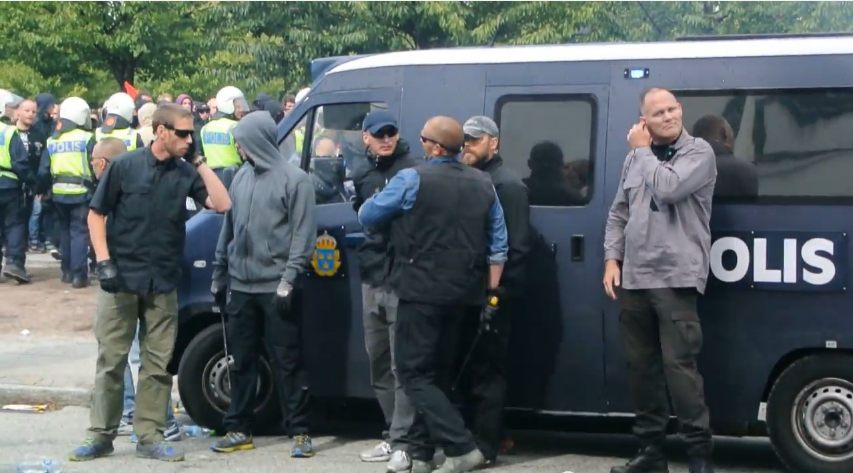
Typical Romeo squad with their transportation. Note the extendable batons which they all carry.
Dialogue officers. Specially trained officers who attempt to build rapport and relationships with activists. These officers attempt to gain information and de-escalate situations, to this end they engage known activists in conversation (and occasional threats). They have no particular power in the police force and their promises are generally without weight in the police hierarchy. Dialogue officers have been known to travel to other countries to aid foreign police forces when Swedish demonstrators are expected in large numbers. Dialogue officers lack armor and don’t engage in arrests or violence as a typical rule (but do appear in courts as witnesses).
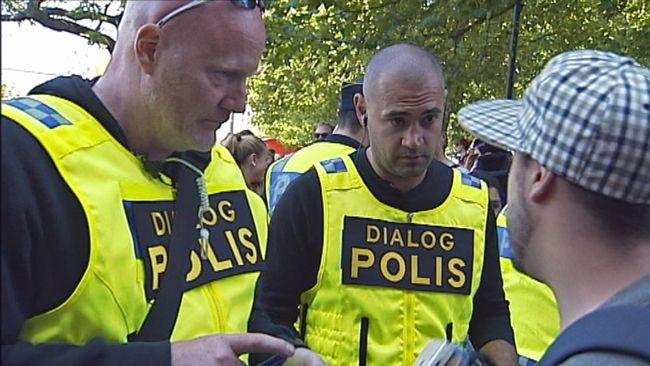
“I really agree with you deep down, my daughter is also a vegan…”
“Foxtrot:” Cavalry. Deployed from 2-6 in a given group. Foxtrot units scout, control space and attempt to scatter masses of protestors. They are armed with a horse whip which causes little pain. Horses are generally skittish and can rear and buck if there is too much chaos.
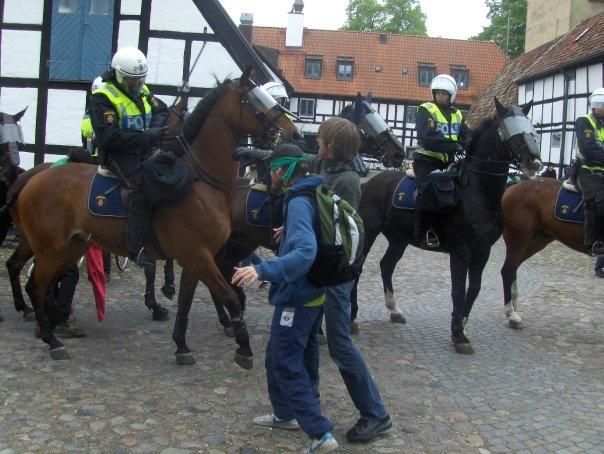
Foxtrot units block a route. Note the whip.
“Echo” (Designation uncertain): Dog handlers and dogs. Deployed individually or in groups up to ten.Their role is to control space. They are transported in a specifically built wagon with cages, alternatively one dog can be kept in a specifically purposed squad car. Police dogs have a tendency to become aggressive towards other dogs and their handlers if chaos erupts.

Echo unit. The dogs are wearing mouth-guards to keep them from biting. These can be taken off.
“Victor:” Transportation of arrestees. Victor units transport individuals who have been arrested or detained through either repurposed regular police buses or specifically chartered buses. The sudden appearance of Victor units might be an indication that police are getting ready for mass arrests.
Reinforced Regional Task Force (“Piketen”). “Elite” unit which also takes part in riot situations. They are recognizable by the fact that they wear black uniforms. In non-riot situations they function as a Swedish SWAT-team. Designation during riots is unknown.
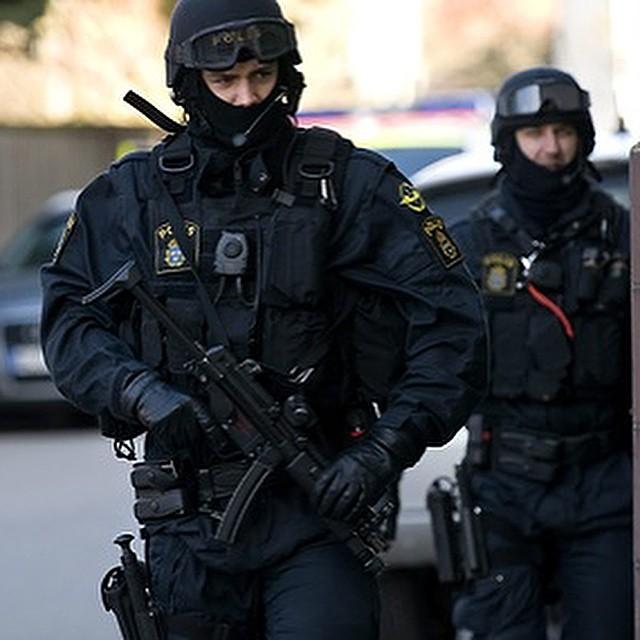
Black uniformed RRTF-officers. They do not deploy with machine guns during demonstrations and instead favor the typical riot-gear of Delta officers.
Helicopter. The helicopter or helicopters serve as scouts. They can only be airborne for a few hours before they have to land and refuel. Designation during riots is unknown.
Other units:
These units are irregular in that they are not central to the police concept. They do however occasionally appear in the streets.
Secret police officers. Occasionally secret police officers have been spotted at mass events as leadership or for unknown reasons.
Media spokes people and social media team. Police bring in media spokes people in order to justify their actions and the size of their mobilization in mass media. Before the demonstration it is these individuals who also attempt to shape the behavior of different groups of demonstrators and to prepare the public for their planned intervention. Their social media team attempts to influence the public and the media in order to “maintain the image of the police.”
Police trainees (“Polisaspiranter”). Occasionally used to hand out flyers or to stand by and learn. Recognizable by wearing reflexive vests with the term Polisaspirant printed on it.
Police volunteers (“Polisvolontärer”). Non-police individuals with no particular training or rights. They occasionally appear in reflexive vests with the term Polisvolontär printed on it. Their role is then to hand out flyers about police actions.
Vehicles:
Beyond the vehicles mentioned above there are several other vehicles used by police officers.

Squad car (“Radiobil”). Lacks armor.
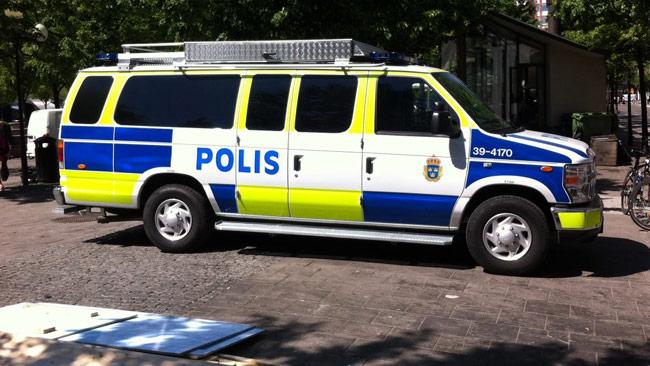
Reinforced bus, the ladder on the top indicates it’s use by the RRTF-unit. (“Piketbuss”)
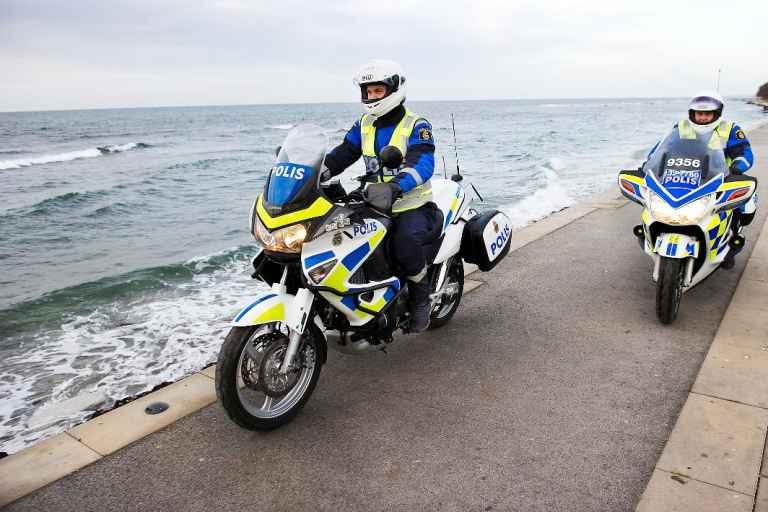
Motorcycles are used to block traffic around the demonstration route and occasionally they move in the front of demonstrations to “guide” the demonstration.
Equipment and weapons:
Police officers wear riot armor, boots and helmets. They have microphones in earplugs that they use to communicate. All police officers have pistols in their belt. Police use a form of ammunition which is forbidden in the Geneva convention.
Police in Sweden use two types of batons during demonstrations:
Expandable baton. This metal baton can be made ready by a swift flick of the wrist, officers usually flick it backwards over their shoulder to have it ready to strike. The tip of the baton can crush bone. However, the rest of it causes little damage if the tip misses.
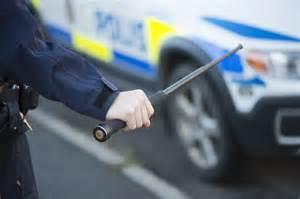
Riot baton. Used exclusively during rioting as a club. The baton causes deep bruises and can smash organs inside of the body. Longer and heavier than the expandable baton.
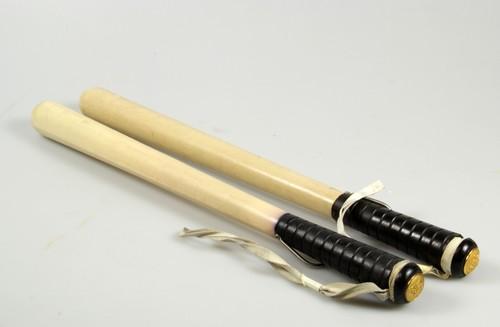
Pepper spray: All police officers have cans of pepper spray. They use these as a short-range weapon to force crowds back.
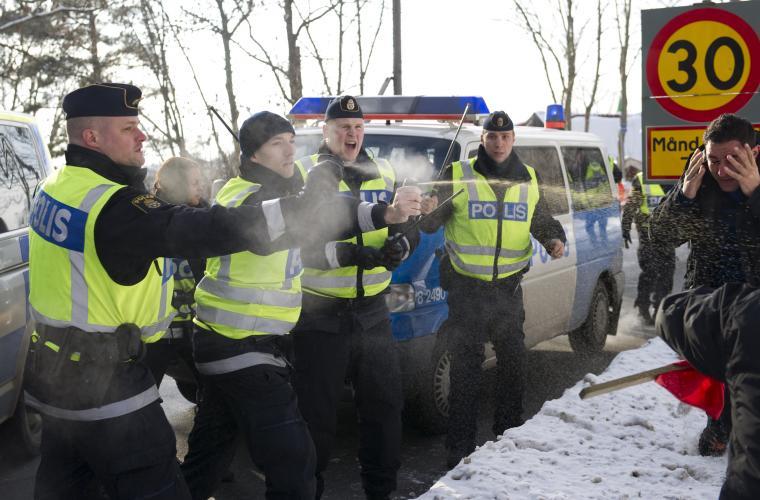
Swedish police does not use tear gas, except against squatted houses and in hostage situations, and do not use water cannons. They have often stated that these weapons of riot control are the opposite of the SPT strategy as they attack groups on a collective level.
The Failure of SPT While SPT sometimes appears to be a refined strategy of riot control it is in reality less than perfect and there are multiple situations where it has been fought successfully. There are two opponents of SPT, activists and police officers. Their joint opposition and interplay has together made the concept fail during many occasions. For many police officers the (relative) lack of forceful attacks against activists who disturb the peace or break the law have made them intervene against the wishes of their commanders. This has at times caused the total breakdown of the concept.
In Sweden it is the Gothenburg police who are the masters and proponents of SPT. The Skåne and Stockholm police regions are more skeptical of the concept and routinely deploy massed groups of police officers, cause unnecessary conflicts and superfluous attacks and so on. These collapses of the tactic are due to activist solidarity, pressure and overall capacity for resistance. It has forced the creation of American-style “designated protest zones” during opposition to fascist still-standing demonstrations with huge rows of police behind fences and checkpoints in which demonstrators have to subject themselves to searches before entering.
There are also many occasions when police have mass detained random individuals after a demonstration is over, possibly due to the need to raise the amount of arrestees in order to justify the cost of their deployment. The many broken promises of the dialogue police which have been overruled by their commanders have also been a part of weakening the strategy.
Source
Polisinsatsen vid ESF-konferensen I Malmö 2008 https://polisen.se/Aktuellt/Rapporter-och-publikationer/Tillsynsrapporter/Publicerat-Tillsynsrapporter/2010/Polisinsatsen-vid-ESF-konferensen-i-Malmo-2008/
Polisens planering inför ESF-konferens i Malmö 2008 https://polisen.se/Aktuellt/Rapporter-och-publikationer/Tillsynsrapporter/Publicerat-Tillsynsrapporter/2010/Polisens-planering-infor-ESF-konferens-i-Malmo-2008/
Nationell polistaktik, insats mot folkmassa http://www.sverigescenen.com/imf.html
Särskild polistaktik https://polisen.se/Om-polisen/Sa-arbetar-Polisen/Sarskild-polisstaktik/
Nationella förstärkningsorganisationen https://polisen.se/Om-polisen/Specialkompetenser/Nationella-forstarkningsorganisationen/
Mukare polistaktik gav hårdare tag https://research.nu/mjukare-polistaktik-gav-hardar...
Academic Center for Autonomous Brigades

